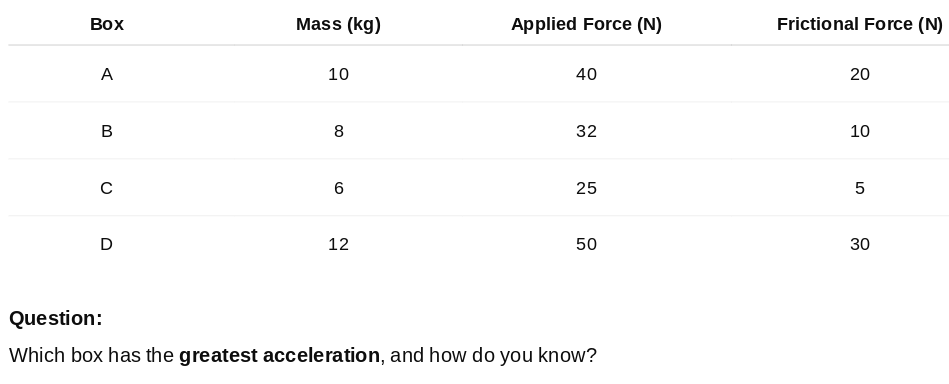What is the equation that shows how force, mass, and acceleration are related?
F = ma
If the force doubles but mass stays the same, what happens to acceleration?
Doubles
A 25 kg box is pushed with 200 N of force. Friction resists with 50 N. What is the acceleration?
F = 200 N - 50N = 150N
a=F/m
a = 150 N ÷ 25 kg = 6 m/s²
Why does a heavier cart accelerate less when pushed with the same force?
More mass → less acceleration.
Which part of the situation demonstrates Newton’s Second Law?
A. The car slows down because friction reduces its motion.
B. The seatbelt applies a force that slows the passenger’s acceleration.
C. The passenger’s body resists change in motion.
D. The passenger pushes against the seatbelt.
B. The force of the seatbelt changes acceleration (F = ma).
A 100 kg cart accelerates at 2 m/s². What is the net force?
F = ma
100 kg × 2 m/s2 = 200 N
When the force applied to an object increases or decreases (and mass stays the same), what happens to the acceleration of the object?
Acceleration increases when force increases and decreases when force decreases.
Two students push the same cart:
Student A uses 100 N, Student B uses 150 N.
The cart’s mass is 50 kg.
Who creates more acceleration, and by how much?
A = 2 m/s² , B = 3 m/s²
B accelerates more by 1 m/s²
If the mass increases but the acceleration stays the same, what happens to the force?
The force increases, because more mass needs more force to keep the same acceleration.
Which example demonstrates Newton’s Second Law?
A. The heavier ball accelerates less because of its greater mass.
B. The player’s foot pushes back with equal and opposite force.
C. Both balls stay still until kicked.
D. The lighter ball rolls farther due to friction.
A. More mass = less acceleration when force is constant (F = ma).
Two students pull a 120 kg cart with a total of 360 N. What is the acceleration?
a= F/m
a = 360 N ÷ 120 kg = 3 m/s²
When the mass of an object increases or decreases (and the force stays the same), what happens to the acceleration?
Acceleration decreases when mass increases and increases when mass decreases.
A student is pulling a 100 kg cart, accelerating at 1.5 m/s². A second student joins and the acceleration increases to 2.5 m/s².
With how much force is the second student pulling?
F₁ = 100 kg x 1.5 m/s2 = 150 N
F₂ = 100 kg x 2.5 m/s2 =250 N
250-150 = 100 N
Object A: 100 N, 50 kg. Object B: 200 N, 100 kg. Which accelerates more?
They accelerate equally (2 m/s²).
Which part shows Newton’s Second Law?
A. The coaster continues moving after the hill.
B. Gravity’s force causes the coaster to accelerate down the track.
C. The seat pushes upward on the rider.
D. The safety harness keeps the rider in place.
B. The unbalanced force (gravity) causes acceleration (F = ma).
A rocket has a thrust of 10,000 N and a mass of 2,000 kg. What is the acceleration?
a=F/m
a = 10,000 N ÷ 2,000 kg = 5 m/s²
When the mass of an object increases or decreases (and the acceleration stays the same), what happens to the force with which it will collide?
The force increases when mass increases and decreases when mass decreases.

Box C. F= 25 N – 5 N = 20 N
a = 20 N ÷ 6 kg = 3.3 m/s² (highest acceleration because it has the largest net force per mass).
If two students push the same cart and acceleration increases, what changed?
The total (net) force increased.
Which example best represents Newton’s Second Law?
A. Plates stay still until acted on by a force.
B. Plates push each other with equal and opposite force.
C. Plates accelerate faster when the convection currents force increases.
D. Plates continue moving at the same speed without resistance.
C. Greater force from convection → greater acceleration of plates.
A car has a net force of 900 N and an acceleration of 3 m/s². What is its mass?
m = F/a
m= 900 N ÷ 3 m/s2 = 300 kg
If net force is zero, what can you say about acceleration?
There is no acceleration.
 Which car and trailer system will have the greatest acceleration, and which will have the least acceleration?
Which car and trailer system will have the greatest acceleration, and which will have the least acceleration?
Greatest acceleration:
Car 2 + Trailer X (smaller total mass = 900 kg)
Least acceleration:
Car 1 + Trailer Y (larger total mass = 1,200 kg)
A student doubles both force and mass. What happens to acceleration?
It stays the same.
Which describes Newton’s Second Law?
A. The baseball accelerates more because it has less mass.
B. The bat feels an equal force from the ball.
C. The balls remain still until acted on.
D. The ball’s velocity stays constant after the hit.
A. Lighter mass = greater acceleration for same force.